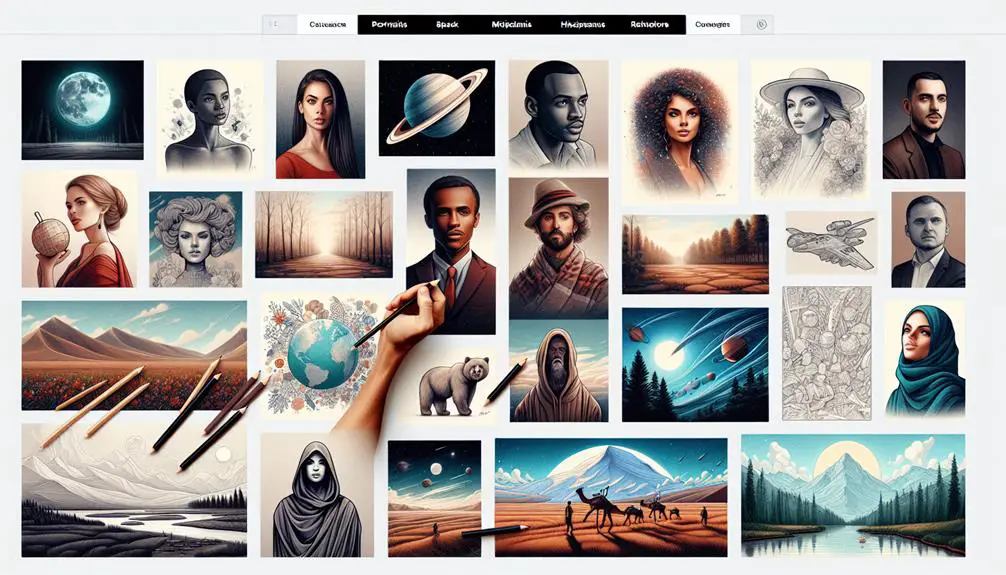As an illustrator, I’ve often found that navigating the freelance world can feel like trying to sketch in the dark. It’s not just about creating beautiful artwork; it’s about understanding how to turn your passion into a sustainable income.
I’ve come to learn that there are specific strategies and techniques that can help freelance illustrators reach that coveted $4000 a month mark. It involves more than just talent; it requires a combination of skill development, business savvy, and a keen understanding of the industry.
If you’re interested in learning how to turn your artistic talent into a reliable source of income, stay tuned.
Key Takeaways
- Invest in developing computer skills for digital transformation in the freelance illustration industry.
- Build a strong and diverse portfolio that showcases technical abilities and reflects advancements in skills and style.
- Utilize networking and marketing strategies, such as attending industry events, utilizing social media platforms, and collaborating with other professionals, to expand client base.
- Research industry standards and adjust rates accordingly, considering factors such as complexity, usage rights, and skill/experience, to ensure fair and attractive pricing for potential clients.
Understanding the Freelance Illustration Industry
As a freelance illustrator, I bring drawings to life and create visually attractive digital pieces of work. The freelance illustration industry offers a diverse range of opportunities, from designing wedding invites, greeting cards, book covers, to illustrating customer memories. It’s essential for illustrators to hone their computer skills to transform traditional drawings into captivating digital images.
Additionally, investing in art courses or developing basic drawing skills can lay a strong foundation for a successful career in this field.
Building an online portfolio and showcasing work on platforms like Behance and Instagram can attract clients and job opportunities. This digital presence is crucial for reaching a wider audience and securing freelance projects.
To effectively manage a freelance illustration business, setting boundaries, tracking income, investing in professional tools, continuously marketing oneself, and adjusting rates as skills grow is imperative.
Understanding the freelance illustration industry isn’t just about artistic skills but also about strategic business acumen. By staying updated with industry trends and continuously refining one’s craft, freelance illustrators can position themselves for success in this innovative and dynamic field.
Building a Strong Portfolio

To effectively showcase my skills and attract potential clients in the freelance illustration industry, building a strong portfolio is essential. As an innovative freelance illustrator, I understand the importance of curating a portfolio that not only demonstrates my technical abilities but also reflects my unique style and creativity.
When creating my portfolio, I focus on showcasing a diverse range of projects that highlight my versatility and ability to adapt to different client needs. By including a variety of styles, mediums, and subject matters, I can demonstrate my capacity to bring fresh and original ideas to any project.
In addition to diversity, I prioritize quality over quantity in my portfolio. Each piece included is a deliberate choice meant to captivate and engage potential clients. I ensure that my portfolio is easily accessible and neatly organized, allowing viewers to navigate through my work effortlessly.
Furthermore, I regularly update my portfolio to showcase my most recent projects and to reflect any advancements in my skills and style.
Networking and Marketing Strategies

Networking and effective marketing are crucial for establishing a strong client base and expanding my freelance illustration business. To achieve this, I actively seek out industry events and conferences to connect with potential clients and professionals who appreciate innovative artwork.
Additionally, I utilize various social media platforms to showcase my unique style and attract clients who value creativity and originality.
Collaboration is also key, as I actively seek to partner with other freelancers and professionals for cross-promotion, enabling us to tap into each other’s networks and reach new audiences.
By engaging in these activities, I aim to cultivate a community of like-minded individuals who appreciate and seek out cutting-edge illustration work.
- Attend industry events and conferences to connect with potential clients and professionals who value innovation.
- Utilize social media platforms to showcase my unique style and attract clients who appreciate creativity and originality.
- Collaborate with other freelancers and professionals for cross-promotion, tapping into each other’s networks and reaching new audiences.
Setting Competitive Rates

Researching industry standards and average rates for freelance illustrators is an essential step in setting competitive pricing for my services. By understanding the market, I can ensure that my rates are both fair to me and attractive to potential clients. Here’s a breakdown of factors to consider when determining pricing:
| Factors to Consider | Description |
|---|---|
| Complexity | Intricacy of the project, including details, style, and techniques used. |
| Usage Rights | The extent to which the client can use the artwork, such as for commercial purposes or exclusive rights. |
| Project Timeline | The urgency or flexibility of the project’s deadline. |
| Packages/Tiers | Offering different options to accommodate various client budgets. |
| Skill & Experience | Regularly reviewing and adjusting rates as my expertise and proficiency grow. |
Navigating Freelance Platforms

When navigating freelance platforms, it’s crucial to choose the right one that aligns with your expertise and target audience.
Building a strong profile with your best work and relevant keywords enhances your visibility and attracts potential clients.
Researching and applying for projects that match your skills and interests sets the stage for a successful freelancing experience.
Choosing the Right Platform
After researching and comparing different freelance platforms, I found the best fit for my skills and goals. I chose a platform that aligns with my illustration niche and has a strong reputation for connecting freelancers with high-quality clients. The platform’s user-friendly interface and secure payment system were also key factors in my decision. Additionally, the platform offers robust support for freelancers, including helpful resources and responsive customer service. These features have allowed me to showcase my portfolio effectively and leverage the platform’s job matching algorithms to attract clients consistently.
- Prioritize platforms that cater to your specific niche or industry to maximize job opportunities.
- Consider the platform’s reputation, user base, and fee structure before creating a profile.
- Look for platforms that offer secure payment systems and provide support for freelancers.
Building a Strong Profile
Having chosen the right platform that aligns with my illustration niche and offers robust support for freelancers, I now focus on building a strong profile to showcase my best work and attract high-quality clients.
Crafting a visually appealing portfolio on the freelance platform is crucial. I utilize its features to personalize my profile, highlighting my unique skills and style as an illustrator. A captivating and professional bio effectively communicates my expertise and passion for illustration.
Showcasing client testimonials and positive feedback builds credibility and trust with potential clients. Continuous updates and diverse examples of my work demonstrate versatility and growth as an illustrator.
Managing Client Relationships

When working with clients as a freelance illustrator, clear communication is vital for understanding their needs and expectations.
Setting boundaries early on helps manage their expectations and prevents misunderstandings.
Clear Communication
To ensure successful client relationships as a freelance illustrator, it’s crucial to establish clear communication channels that foster understanding and alignment of project objectives.
Proactively seeking and providing feedback maintains open and transparent communication throughout the project.
Setting realistic expectations with clients regarding timelines, revisions, and deliverables avoids misunderstandings.
Promptly and professionally addressing any concerns or questions from clients builds trust and rapport.
By regularly updating clients on the project’s progress and seeking their input, their vision can be realized effectively.
This approach not only ensures a smooth workflow but also demonstrates a commitment to delivering high-quality work that meets the client’s needs and expectations.
Setting Boundaries
Navigating client relationships as a freelance illustrator requires clear communication to lay the foundation for successful projects. Clearly communicate your working hours and response times to manage expectations and prevent burnout. It’s crucial to establish a scope of work and timeline for each project to prevent scope creep and ensure timely delivery. Setting guidelines for revisions and additional requests maintains project focus and avoids unnecessary workload.
Establishing firm boundaries is also necessary to ensure a healthy work-life balance and project management. Define acceptable communication channels and frequency to maintain productivity. Additionally, outlining payment terms and policies ensures fair compensation and timely payments for your work.
Expanding Your Skill Set

Diversifying your portfolio by learning new illustration techniques and styles can greatly enhance your freelance illustration career. As an illustrator, I constantly seek to expand my skill set to stay ahead in the competitive industry. Here’s how I’ve been doing it:
- I’ve been experimenting with different mediums such as watercolor, digital, and mixed media illustrations to bring diversity to my work.
- Collaborating with other artists and professionals has provided me with new perspectives and skills, helping me grow as an illustrator.
- Taking advanced courses and workshops has allowed me to enhance my expertise in specific illustration niches, making me more versatile and in-demand.
In an industry that values innovation, it’s crucial to stay updated on industry trends and incorporate new tools and software into your workflow. By expanding my skill set, I’ve not only increased my earning potential but also found a deeper sense of fulfillment in my work.
Maintaining Consistent Income

Developing long-term relationships with repeat clients is crucial for maintaining consistent income as a freelance illustrator. By nurturing these relationships, I ensure a steady stream of projects and income. Additionally, offering a variety of illustration services to different clients helps diversify my income streams. This approach not only keeps my work engaging and innovative but also provides financial stability. Furthermore, I provide design packages and subscriptions, creating a reliable income source. To attract new clients consistently, I market my skills through targeted advertising and promotions, staying ahead of industry trends. Adapting my services to meet current market demands ensures a steady flow of work. Through these strategies, I prioritize maintaining a stable income while continuing to push the boundaries of creativity and innovation.
| Strategy for Consistent Income | Benefits | Emotion |
|---|---|---|
| Long-term client relationships | Steady projects and income | Trust |
| Diversifying services | Financial stability | Security |
| Design packages/subscriptions | Reliable income source | Peace of mind |
| Targeted marketing | Attracting new clients | Excitement |
| Adapting to industry trends | Steady flow of work | Confidence |
Conclusion
I’ve learned that earning $4000 a month as a freelance illustrator is achievable with dedication and strategic planning. While it may seem daunting at first, by continuously improving my skills, networking effectively, and managing my business smartly, I can reach my income goals.
Some may argue that the freelance illustration industry is too competitive, but with the right mindset and perseverance, success is within reach for those who are willing to put in the effort.


